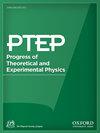电弱相互作用矢量暗物质模型中一阶相变产生的引力波
IF 8.3
4区 物理与天体物理
Q1 Physics and Astronomy
引用次数: 0
摘要
我们讨论电弱相互作用矢量暗物质模型中的引力波。在该模型中,电弱规对称性被扩展为SU(2)0 × SU(2)1 × SU(2)2 × U(1)Y,并在TeV尺度下自发地破碎为SU(2)L × U(1)Y。该模型在 SU(2)0 和 SU(2)2 之间具有交换对称性。这种对称性稳定了一些与上述自发对称性破缺相关的大质量矢量玻色子,其中一个电中性矢量玻色子是暗物质的候选者。之前的研究发现,SU(2)0 和 SU(2)1 的规耦合相对较大,可以通过冻结机制解释暗物质能量密度的测量值。有了大的规耦合,规玻色子就有可能对标量势产生相当大的影响。本文主要研究 SU(2)0 × SU(2)1 × SU(2)2 → SU(2)L 的相变。我们计算了有限温度下的有效势,发现在参数空间的很大范围内,相变是一阶强相变。强一阶相变会产生引力波。我们计算了引力波频谱,发现未来的天基引力波干涉仪有可能探测到模型中预测的引力波。我们探索了引力波探测所探测到的参数空间区域。我们发现引力波探测可以探测到模型中CP偶合标量h′的质量为几TeV的区域。本文章由计算机程序翻译,如有差异,请以英文原文为准。
Gravitational waves from first-order phase transition in an electroweakly interacting vector dark matter model
We discuss gravitational waves in an electroweakly interacting vector dark matter model. In the model, the electroweak gauge symmetry is extended to SU(2)0 × SU(2)1 × SU(2)2 × U(1)Y and spontaneously broken into SU(2)L × U(1)Y at TeV scale. The model has an exchange symmetry between SU(2)0 and SU(2)2. This symmetry stabilizes some massive vector bosons associated with the spontaneous symmetry breaking described above, and an electrically neutral one is a dark matter candidate. In the previous study, it was found that the gauge couplings of SU(2)0 and SU(2)1 are relatively large to explain the measured value of the dark matter energy density via the freeze-out mechanism. With the large gauge couplings, the gauge bosons potentially have a sizable effect on the scalar potential. In this paper, we focus on the phase transition of SU(2)0 × SU(2)1 × SU(2)2 → SU(2)L. We calculate the effective potential at finite temperature and find that the phase transition is first-order and strong in a wide range of the parameter space. The strong first-order phase transition generates gravitational waves. We calculate the gravitational wave spectrum and find that it is possible to detect the gravitational waves predicted in the model by future space-based gravitational wave interferometers. We explore the regions of the parameter space probed by the gravitational wave detection. We find that the gravitational wave detection can probe the region where the mass of h′, a CP-even scalar in the model, is a few TeV.
求助全文
通过发布文献求助,成功后即可免费获取论文全文。
去求助
来源期刊

Progress of Theoretical and Experimental Physics
PHYSICS, MULTIDISCIPLINARY-PHYSICS, PARTICLES & FIELDS
CiteScore
12.00
自引率
5.70%
发文量
148
审稿时长
17 weeks
期刊介绍:
Progress of Theoretical and Experimental Physics (PTEP) is an international journal that publishes articles on theoretical and experimental physics. PTEP is a fully open access, online-only journal published by the Physical Society of Japan.
PTEP is the successor to Progress of Theoretical Physics (PTP), which terminated in December 2012 and merged into PTEP in January 2013.
PTP was founded in 1946 by Hideki Yukawa, the first Japanese Nobel Laureate. PTEP, the successor journal to PTP, has a broader scope than that of PTP covering both theoretical and experimental physics.
PTEP mainly covers areas including particles and fields, nuclear physics, astrophysics and cosmology, beam physics and instrumentation, and general and mathematical physics.
 求助内容:
求助内容: 应助结果提醒方式:
应助结果提醒方式:


